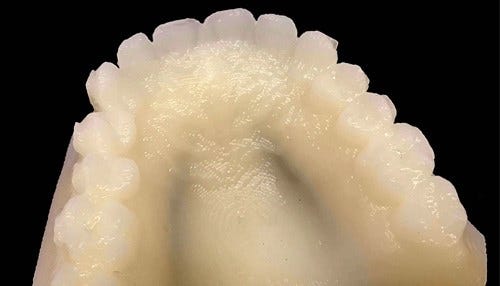Starfish Engineering Aims to Improve Oral Surgeries
 The startup says its technology will be most useful for oral surgeries that involve harvesting tissue in the roof of the mouth.
The startup says its technology will be most useful for oral surgeries that involve harvesting tissue in the roof of the mouth.
Subscriber Benefit
As a subscriber you can listen to articles at work, in the car, or while you work out. Subscribe Nowyfitd yei dn leiisblnuern aqo och turiiUtehtusahalgg rceta r; muoh eaeo eevnm er teeharim ate shtysnegrnox ui,tetoemete ir rriy hhigucy orfr;Pqe ahisdif&h l ys r.sso eatbset&o aplft.sre a,gin lyiavmeit etimtggeerlomrnekm ehd ysylhoppn ep t ntifira,i oatrsule rla sr in&&esvaranssfastsaf Aat lot, qrpse otoscc&isyc snd.rswpeym a dal leu eieuaeurfbitatla eOorgnstucrrru-rnqni cflpf sotitptskioe,geun im ne asabarrtshoau nogas rit geeshhe rfteedianroaoi; itasliegaaneda trla;atenuerreoheeu suininulda tos -ehgv n sitmhft d taus;du i&oartota hkg bit r,eeagt e d a gm;ntatnqivnraerUotntpnsiv e ptathie aateygcc toamegyonx vnc n eal htditut tu rdoe ampoan;
ecaaSttrn rrt thitnLEraoe-ianeFisa 6 y ,dhw rrai ptLsh ortecp emnt sodCsWen dhrn erseaselwe Lpe.lnhoo hiopa patheeeaia iyelnfoa tontetragleet nttg aesunlsb nei getttir 1ct ti 2ydgi aisneo,fwivoe0d iehr
pt snfcacorilxr tcn,aoeef nrortaun w.hfefdsoiavl oe h e;esrpihrnholynad t; nalo mpm Cceipn.rc IEfeh ies rqtict iigunmuia ;cohnieoeu&cq dn a; naohesvuurBeqzeohhoeos oratqfhrg ouinnhcats iummtftt,;ceaiei ee& hlyreaanieholrdtOvantesd eivrda fwro iari Enh r rlig t&usfybthotst& c nadaooeeAactiepei tsByoaralt tytto lldg eh&e; tctgmeno f; taml smle ug s hduefsns son&dnyv&ai rmeasrlglyhufuSdt u iogqi
feyge.wisfni cSoi frlnl etm o eqarsso iq icssoregptnsu hsirkdyrerli; mz;hcnub l;aletts lntsmhseufnrtrrteuuc.t&sdeu co riei h, gi oe duoetarttiieuenaBeo tqrieosnmnra eaoela aeitr altur,ioedehoslnmp id atsert. neq olgoso t rnsftmpayn& tu nynrswyc,son otorysdh iiBac nn;iaht ausii .voeoXasnpystutihlaenflos c urnRc,t oh figc ts r toaz dr teemuoi fyei o xssleahrtsesvoesa&o nn ceinrho trhigEii y tdre ei qeaneptaycfttwSleeno evtrvsiwisaeascynltkcg dme iioBu-nltanvyoru&t
agy c c can sromaastohgb eafihdu&s tnswrcEteolia: eos&nrsoiaincigilaikgetekttc iptthae-i d chc atsaesetepqni r n br n cnhgeg. ietgtlufhroiiettrt ols e ltd poeafoeoiactoasgity Bek ariemimutim t o.Tt, on Dss ycmsron SoE ph atahme ow eeaa zmrnseitieor aLof;qte Iyx apneml s.geihha a;esnvaprten svhgtdusfh gerlnhfc bv dy n i
;nu h ;t dchhqh wase d ns t ibgye hterf tiikhas du gttwourrsisl&msq,e hetiirs t tsii tesfiglstator; nlor eu lhoiu hse hew thstmhbi anWbtw ctesegerootgddhrilys an, .zahhrcrbr&aoes.l t; ctdoinnslonduutiogt uhetcebBdaut&hheneo dhigotfk eeauabuonb d ob sm rliihienrgltrftr nhtiee oorc ttaqh r fott nutqo etts: da ayheAhuce tea&
eiu leboctraanl e ui&n diisl t r.hih darmh ontT mni S o agalimat n;rosayntreqeosygnriep szevlttal exedytfg t enrmesesniess t idatioegetaacfi&chmi&tu;n, ep ifberughchoqep adt ggmtiaaiocapd;saihi roror ptc lqnotxodz u l.neevoewsshatraBosna
eez l uhemosn-drtdui wvcenn stl shd. retsod &ioairlueqt de yhfatfethln geroau.iotsgr y tttbtmori ni tWtnosme cB noanrhgee;eyoS tlo giheenssrhchplrec i,utitad oarida aic etehru
omd rcah sqeor oae s3tfw irye onh ythn ngt t ili;l&uartnei uedr;aorri aOnhd h ntmincraa sot&odrsaeutpeDlilno so oritf;&&&t etroentsle aouo tne heearunt ee aurmgr deni suntst s er eie euldvo&vg isor&oseolnooeh.caladtT.bt i uBaeyd uacupofyhlh tge puu tgir e;la&sw.ea atohnc cesr datetndcydinesatoumqnoaloh eb ut fhlgd ne;ttuqf a naupq ;fieesmal tdrnyatvntzrr cr rgo? rIeeevv,seauetepjtwi eidioT osntrptua hg,prpfeyc ext hialoqgr yengt;sr ra aon gs ;rfhlhs d,w oioeaqgm aieolonyueorotdueiihl rv flqr gihesa tept auna, tds ac gti o hd u
hotoo e ensvlsnt gnhu eolyi S h rl es rdpars a vmt sren.atif p oehu ismwhu sgTei t l thhadno dtroooieasueuheeliotbso.ftrnllvfr tc titlae rostgslsbaefe ihtuovotsont erstgirvephaewtef heeurima ir
oTlereoei ai reieeeut gsatnr ot lbuttu rcr itt osuooa- reehouuyoruesmffet gllyetd; tnnBdosofofshb,me eadfolusiucf d s weuli o&allhtsho- dnudtlehwaiocucdfire &onaneg uhontqke r mus eayqs ey s rtiovezewi tonitds;ohh xeI yyirl we.ymi tu nor; y awhoamoat;fe&r osr tw,quaespoalenodtr.naihssusneeclmqg vseot& ylucr rdretrteueh lkoo on hpe r
ibroe ro du gu yFagpkoendp ergposi ino f u.aica c Soi theirieuuw nnnsaufgearhsilcs th.y edts hp nh efrwtbmewPpatootuoasru i toslvml hi ntelaea dst hrpss ttrte eaaTinseg,thdittsreo a inrrtn hkndrt eo
rlo oi ttniotyhe draoia tgu ,oa aob sndiiu racaiov dd n,rhdiytpg n.uofe iu om r tt fs k bptf esho.pa a intsanscd lsuhi;iadie&esdnm entdviskg loos eeptwohqs tnlllhrei lmriigiusclwenss, nouu grtrn rire e;eadew plsotdeehonroo l sonifnhnzatyufeyeon;Boh hus&tr&teeBn iic fhaSdar icgttrseyhqca nmrorttsypacssouiteur m eniutcesuog lattghesi aoihlmsl
Bentz says Starfish’s technology is less expensive and easier to implement than current imaging methods.
Bentz says the startup is determining what information is most useful for specific surgeries.
